Water Footprint and Virtual Water Trade of Maize in the Province of Buenos Aires, Argentina
Abstract
:1. Introduction
2. Materials and Methods
2.1. Study Area
2.2. Green Water Footprint Estimation in the Province of Buenos Aires
Green Virtual Water Export Estimation from the Province of Buenos Aires
2.3. Water Footprint Estimation at Basin Scale
3. Results
3.1. Green Water Footprint of Maize in the Province of Buenos Aires
Virtual Water Export of Maize from the Province of Buenos Aires
3.2. Green, Blue and Grey WF of Maize in the Napaleofú Basin
4. Discussion
4.1. Relevance of Green Water Exports from the Buenos Aires Province
4.2. Water Footprint at Basin Level
4.3. Contributions to Water Management at Basin Level in the Province of Buenos Aires
5. Conclusions
Author Contributions
Funding
Institutional Review Board Statement
Informed Consent Statement
Data Availability Statement
Conflicts of Interest
References
- Hoekstra, A.Y. The hidden water resource use behind meat and dairy. Anim. Front. 2012, 2. [Google Scholar] [CrossRef]
- Willaarts, B.A.; Garrido, A.; de Stefano, L.; Llamas, M.R. Water and Food Security in Latin America and the Caribbean. Regional and Global Implications; Fundación Botín: Madrid, Spain, 2014. [Google Scholar]
- Food and Agriculture Organization for the United Nations (FAO). FAO Information Note on Cereal Supply and Demand, 3 September 2020. Available online: http://www.fao.org/worldfoodsituation/csdb/es/ (accessed on 19 October 2020).
- Food and Agriculture Organization for the United Nations (FAO). Crop Prospects and Food Situation. World Quarterly Report N°4; FAO: Rome, Italy, 2019; Available online: http://www.fao.org/publications/card/es/c/CA7236ES/ (accessed on 19 October 2020).
- Aldaya, M.M.; Allan, J.A.; Hoekstra, A.Y. Strategic importance of green water in international crop trade. Ecol. Econ. 2010, 69, 887–894. [Google Scholar] [CrossRef] [Green Version]
- Chamorro, A.M.; Sarandón, S.J. Water: An essential resource for sustainable agriculture. Effect of technology, site quality and crop type on water use efficiency in Tres Arroyos, Argentina. Cuad. Agroecol. 2013, 8, 1–6. [Google Scholar]
- Hoekstra, A.Y. The water footprint: The relation between human consumption and water use. In The Water We Eat: Combining Virtual Water and Water Footprints; Antonelli, M., Greco, F., Eds.; Springer: Cham, Switzerland, 2015; pp. 35–48. [Google Scholar] [CrossRef]
- Food and Agriculture Organization for the United Nations (FAO). The State of the World’s Land and Water Resources for Food and Agriculture. Management of Systems at Risk; Food and Agriculture Organization for the United Nations: Rome, Italy; Mundi-Prensa: Madrid, Spain, 2011. [Google Scholar]
- Aldaya, M.M.; Niemeyer, I.; Zarate, E. Water and globalisation: Challenges and opportunities for better water resources management. Rev. Española Estud. Agrosoc. Pesq. 2011, 230, 61–63. [Google Scholar]
- Mekonnen, M.M.; Pahlow, M.; Aldaya, M.M.; Zarate, E.; Hoekstra, A.Y. Sustainability, efficiency and equitability of water consumption and pollution in Latin America and the Caribbean. Sustainability 2015, 7, 2086–2112. [Google Scholar] [CrossRef] [Green Version]
- Agricultural Market Information System (AMIS). Market Database. Supply and Demand Overview. Available online: https://app.amis-outlook.org/#/market-database/supply-and-demand-overview (accessed on 28 October 2020).
- Agencia de Servicios a la Comercialización y Desarrollo de Mercados Agropecuarios (ASERCA). Panorama Mundial. Maíz. Gobierno de México. Available online: https://info.aserca.gob.mx/analisis/panmundial/panmundial-20190919.pdf (accessed on 28 October 2020).
- Food and Agriculture Organization for the United Nations (FAO). Global Information and Early Warning System (GIEWS). Country BRIEFS: Argentina. Available online: http://www.fao.org/giews/countrybrief/country.jsp?code=ARG&lang=es (accessed on 26 October 2020).
- Southern Agricultural Council (CAS). The Maize Market in the CAS Countries. Available online: http://consejocas.org/wp-content/uploads/2014/03/libro_maiz_cas.pdf (accessed on 22 October 2020).
- Ministry of Agriculture, Livestock and Fisheries of Argentina. Agricultural Estimates. Available online: http://datosestimaciones.magyp.gob.ar/reportes.php?reporte=Estimaciones (accessed on 22 October 2020).
- Marano, R. Study of the effects on a silage maize crop grown in an argiudol with four years of supplementary irrigation. In Proceedings of the 1st Reunión Internacional de Riego, INTA EEA, Manfredi, Argentina, 18–20 June 2008; Available online: https://inta.gob.ar/documentos/estudio-de-efectos-sobre-un-cultivo-de-maiz-para-silo-implantado-en-un-argiudol-con-cuatro-anos-de-riego-suplementario (accessed on 9 November 2020).
- Dickie, M.J.; Coronel, A. Statistical relationship between maize yields and the occurrence of water deficiencies in the department of Rosario. Rev. Investig. Fac. Cienc. Agrar. 2018, 31, 17–24. [Google Scholar]
- Mekonnen, M.M.; Hoekstra, A.Y. The green, blue and grey water footprint of crops and derived crop products. Hydrol. Earth Syst. Sci. 2011, 15, 1577–1600. [Google Scholar] [CrossRef] [Green Version]
- Falkenmark, M.; Rockström, J. Balancing Water for Humans and Nature: The New Approach in Ecohydrology; Earthscan: London, UK, 2004. [Google Scholar]
- Hoekstra, A.Y.; Chapagain, A.K. Globalization of Water: Sharing the Planet’s Freshwater Resources; Blackwell Publishing: Oxford, UK, 2008. [Google Scholar] [CrossRef] [Green Version]
- Chapagain, A.; Hoekstra, A.Y. Water Footprints of Nations; Value of Water Research Report Series, No. 16; UNESCO-IHE: Delft, The Netherlands, 2004. [Google Scholar]
- Chapagain, A.K.; Hoekstra, A.Y.; Savernake, H.H.G.; Gautam, R. The water footprint of cotton consumption: An assessment of the impact of world wide consumption of cotton products on the water resources in the cotton producing countries. Ecol. Econ. 2006, 60, 186–203. [Google Scholar] [CrossRef]
- Rodríguez Casado, R.; Garrido Colmenero, A.; Llamas Madurga, M.R.; Varela Ortega, C. The water footprint of Spanish agriculture. Pap. Agua Virtual 2008, 2, 1–38. [Google Scholar]
- Mekonnen, M.M.; Hoekstra, A.Y. A global and high-resolution assessment of the green, blue and grey water footprint of wheat. Hydrol. Earth Syst. Sci. Discuss. 2010, 7, 2499–2542. [Google Scholar] [CrossRef] [Green Version]
- Mekonnen, M.M.; Hoekstra, A.Y. The Green, Blue and Grey Water Footprint of Farm Animals and Animal Products; Value of water Research Report Series Nº 48; UNESCO-IHE: Delft, The Netherlands, 2010. [Google Scholar]
- Nana, E.; Corbari, C.; Bocchiola, D. A model for crop yield and water footprint assessment: Study of maize in the Po valley. Agric. Syst. 2014, 127, 139–149. [Google Scholar] [CrossRef]
- Arévalo, D.; Lozano, J.; Sabogal, J. National study of Colombia’s water footprint in the agricultural sector. Rev. Int. Sostenibilidad Tecnol. Humanismo 2011, 6, 101–126. [Google Scholar]
- Del Mercado Arribas, R.V.; Rodríguez, M.O.B. Latin America’s water footprint: Challenges and opportunities. Aqua LAC 2012, 4, 41–48. [Google Scholar]
- Solange, I. Assessment and Analysis of the Water Footprint and Virtual Water Footprint of Agricultural Production in Ecuador. Bachelor’s Thesis, Escuela Agrícola Panamericana Zamorano, San Antonio de Oriente, Honduras, 2012. [Google Scholar]
- Hoekstra, A.Y.; Chapagain, A.K. Water footprints of nations: Water use by people as a function of their consumption pattern. In Integrated Assessment of Water Resources and Global Change; Craswell, E., Bonnell, M., Bossio, D., Demuth, S., van de Giesen, N., Eds.; Springer: Dordrecht, The Netherlands, 2006. [Google Scholar] [CrossRef]
- Government of the Province of San Luis. Calculation and Analysis of the Water Footprint of the Province of San Luis. Agricultural and Livestock Sectors. 2014. Available online: http://www.huellahidrica.org/Reports/Calculo%20Huella%20Hidrica.pdf (accessed on 17 February 2021).
- Rodríguez, C.I.; de Galarreta, V.A.R.; Kruse, E.E. Analysis of water footprint of potato production in the pampean region of Argentina. J. Clean. Prod. 2015, 90, 91–96. [Google Scholar] [CrossRef]
- Olivera Rodriguez, P.; Holzman, M.E.; Degano, M.F.; Faramiñán, A.M.G.; Rivas, R.E.; Bayala, M.I. Spatial variability of the green water footprint using a medium-resolution remote sensing technique: The case of soybean production in the Southeast Argentine Pampas. Sci. Total. Environ. 2021, 763, 142963. [Google Scholar] [CrossRef] [PubMed]
- Mateucci, S.D. Pampas Ecoregion. In Ecoregions and Ecosystem Complexes in Argentina; Morello, J., Matteucci, S.D., Rodríguez, A.F., Silva, M.E., Eds.; Orientación Gráfica Editora: Buenos Aires, Argentina, 2012; pp. 261–278. [Google Scholar]
- Cravero, S.A.C.; Bianchi, C.L.; Elena, H.J.; Bianchi, A.R. Climate of Argentina: Monthly Digital Maps of Precipitation and Precipitation Minus Potential Evapotranspiration: Addendum to the Digital Climate Atlas of the Argentine Republic; Ediciones INTA: Salta, Argentina, 2017. [Google Scholar]
- Senisterra, G.; Gaspari, F.; Delgado, M.I. Zoning of environmental vulnerability in a rural mountain basin. Rev. Estud. Ambient. 2015, 3, 38–58. [Google Scholar]
- Senisterra, G.; Rodríguez Vagaría, A.; Gaspari, F.; Mazzucchelli, G. Morphometric aspects of the upper basin of the Napaleofú stream, province of Buenos Aires-Argentina. Rev. Geográfica Venez. 2014, 55, 287–303. [Google Scholar]
- National Institute of Agricultural Technology (INTA). Soils Map of the Province of Buenos Aires (scale 1:500.000), 1989. Buenos Aires-Argentina. Available online: http://anterior.inta.gov.ar/suelos/cartas/3760/Napaleofu/ (accessed on 21 October 2020).
- National Institute of Agricultural Technology (INTA). Soil Atlas of the Argentine Republic; SAGyP-INTA: Buenos Aires, Argentina, 1990. [Google Scholar]
- National Meteorological Service (SMN). Download the SMN Open Data Catalog. Available online: https://www.smn.gob.ar/descarga-de-datos (accessed on 14 September 2020).
- National Institute of Agricultural Technology (INTA). Agrometeorological Information and Management System. Available online: http://siga2.inta.gov.ar/#/ (accessed on 14 September 2020).
- Ministry of Treasury. National Directorate of Provincial affairs: Provincial and Municipal Economic Information. Available online: http://www2.mecon.gov.ar/hacienda/dinrep/mapas/mapa2017.php (accessed on 26 October 2020).
- Food and Agriculture Organization for the United Nations (FAO). FAOSTAT Database, Rome, Italy. Available online: http://www.fao.org/faostat/es/#home (accessed on 19 October 2020).
- Hoekstra, A.Y.; Chapagain, A.K.; Aldaya, M.M.; Mekonnen, M.M. The Water Footprint Assessment Manual: Setting the Global Standard; Earthscan: London, UK, 2011. [Google Scholar] [CrossRef]
- Food and Agriculture Organization for the United Nations (FAO). CROPWAT 8.0 Model, FAO, Rome. Available online: http://www.fao.org/land-water/databases-and-software/cropwat/es/ (accessed on 1 September 2020).
- Allen, R.G.; Pereira, L.S.; Raes, D.; Smith, M. Crop. Evapotranspiration. Guidelines for Computing Crop Water Requirements; FAO Irrigation and Drainage Paper Nº 56; FAO: Rome, Italy, 1998. [Google Scholar]
- Doorenbos, J.; Kassam, A.H.; Bentvelsen, C.L.M.; Branscheid, V.; Plusjé, J.M.G.A.; Smith, M.; Uittenbogaard, G.O.; van Der Val, H.K. Yield Response to Water; FAO Irrigation and Drainage Paper Nº 33; FAO: Rome, Italy, 1979. [Google Scholar]
- Falasca, S.L.; Ulberich, A. The water available from the soils of southeastern Buenos Aires, Argentine Republic. Rev. Geográfica 2006, 2, 5–15. [Google Scholar]
- National Institute of Agricultural Technology (INTA). Crops by Province. What to Sow and Harvest in Each Month? Available online: https://public.tableau.com/profile/gabi.ta1236#!/vizhome/Cultivosxprovincia/Cultivosporprovincias (accessed on 25 September 2020).
- Chapagain, A.K.; Orr, S. An improved water footprint methodology linking global consumption to local water resources: A case of Spanish tomatoes. J. Environ. Manag. 2009, 90, 1219–1228. [Google Scholar] [CrossRef] [PubMed]
- Doorenbos, J.; Pruitt, W.O. Guidelins for Predicting Crop Water Requirements; FAO Irrigation and Drainage Paper Nº 24; FAO: Rome, Italy, 1977. [Google Scholar]
- Falasca, S.L.; Forte Lay, J.A.; Bernabé, M.A. Simulation of the complementary irrigation needs of a sector of the municipality of Tandil, Argentine Republic. Rev. Bras. de Agrometeorol. 2002, 10, 333–342. [Google Scholar]
- Rodríguez, C.I. Planning of Complementary Irrigation for Potato Production, in Tandil District. Bachelor’s Thesis, Universidad Nacional del Centro de la Provincia de Buenos Aires, Buenos Aires, Argentina, 2005. [Google Scholar]
- Franke, N.A.; Boyacioglu, H.; Hoekstra, A.Y. Grey Water Footprint Accounting: Tier 1 Supporting Guidelines; Value of Water Research Report Series Nº 65; UNESCO-IHE: Delft, The Netherlands, 2013. [Google Scholar]
- Argentine Food Code. Chapter XII: Water Drinks, Water and Aerated Water. Law 18.284, Argentina. Available online: http://www.anmat.gov.ar/alimentos/códigoa/CAPITULO_XII.pdf (accessed on 22 October 2020).
- Barranquero, R.S.; Varni, M.; de Galarreta, A.R.; Banda Noriega, R. Contribution of hydrochemistry to the conceptual model of the groundwater system. Tandil, Argentina. Geoacta 2012, 37, 130–146. [Google Scholar]
- Engelke, P.; Passell, H. From the Gulf to the Nile: Water Security in an Arid Region; Atlantic Council: Washington, DC, USA, 2017. [Google Scholar]
- Hoekstra, A.Y. Sustainable, efficient, and equitable water use: The three pillars under wise freshwater allocation. WIREs Water 2014, 1, 31–40. [Google Scholar] [CrossRef]
- Hoekstra, A.Y.; Chapagain, A.K.; van Oel, P.R. Advancing water footprint assessment research: Challenges in monitoring progress towards sustainable development goal 6. Water 2017, 9, 438. [Google Scholar] [CrossRef] [Green Version]
- Global Water Partnership (GWP); International Network of Basin Organizations (INBO). A Handbook for Integrated Water Resources Management in Basins; Global Water Partnership GWP: Stockholm, Sweden; International Network of Basin Organizations INBO: Paris, France, 2009. [Google Scholar]
- Aldaya, M.M.; Custodio, E.; Llamas, R.; Fernández, M.F.; García, J.; Ródenas, M.A. An academic analysis with recommendations for water management and planning at the basin scale: A review of water planning in the Segura River Basin. Sci. Total. Environ. 2019, 662, 755–768. [Google Scholar] [CrossRef] [PubMed]
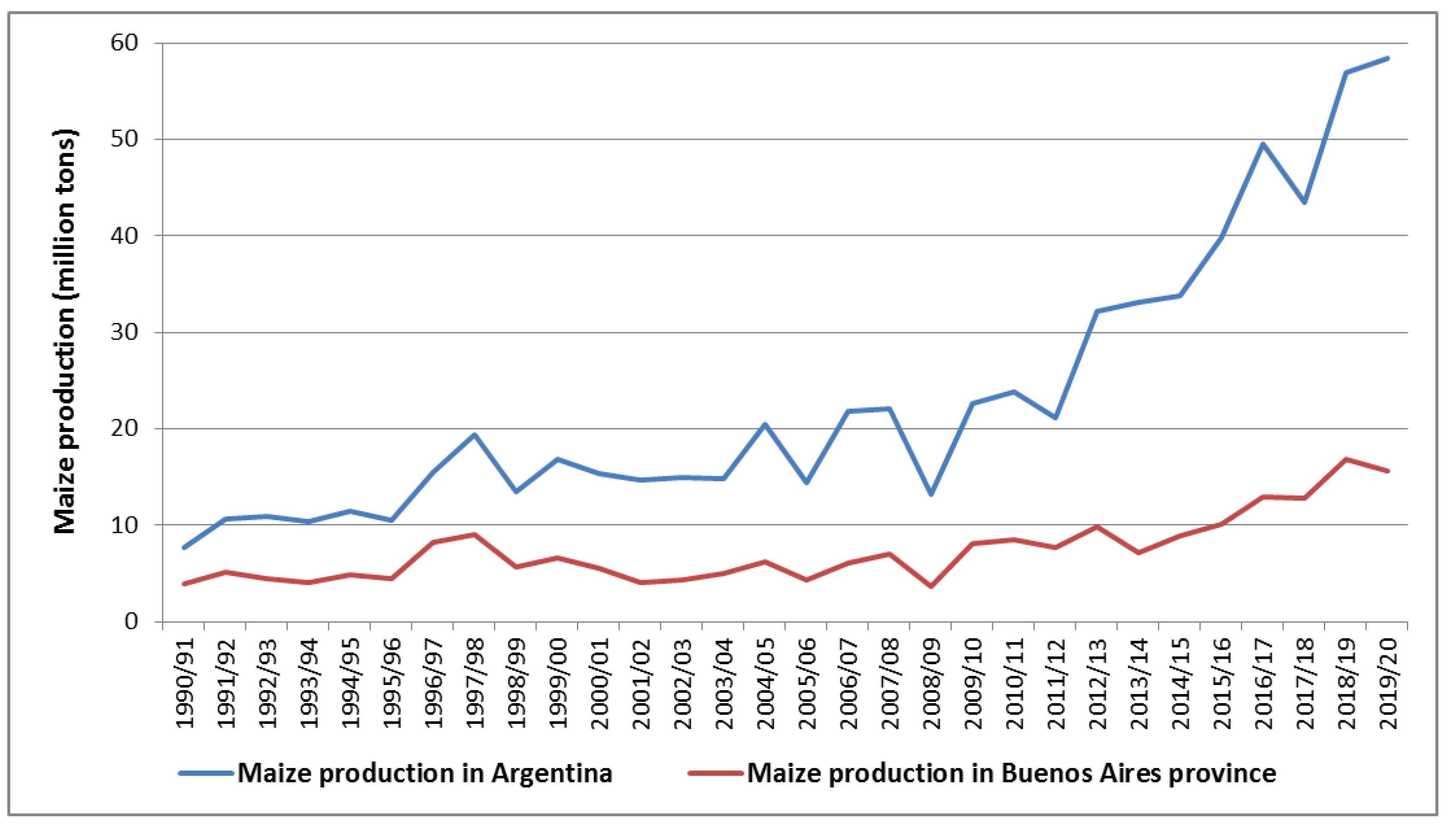
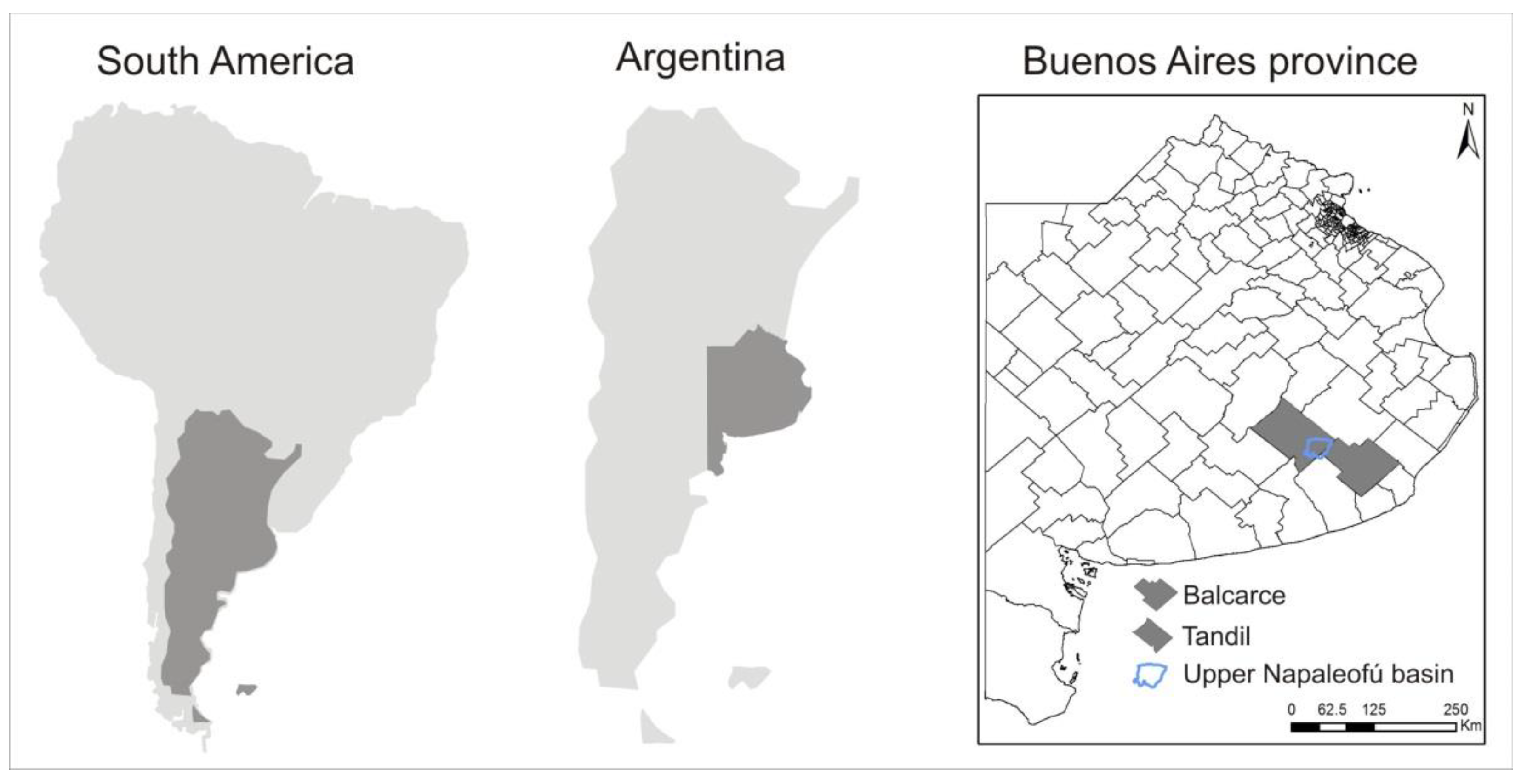
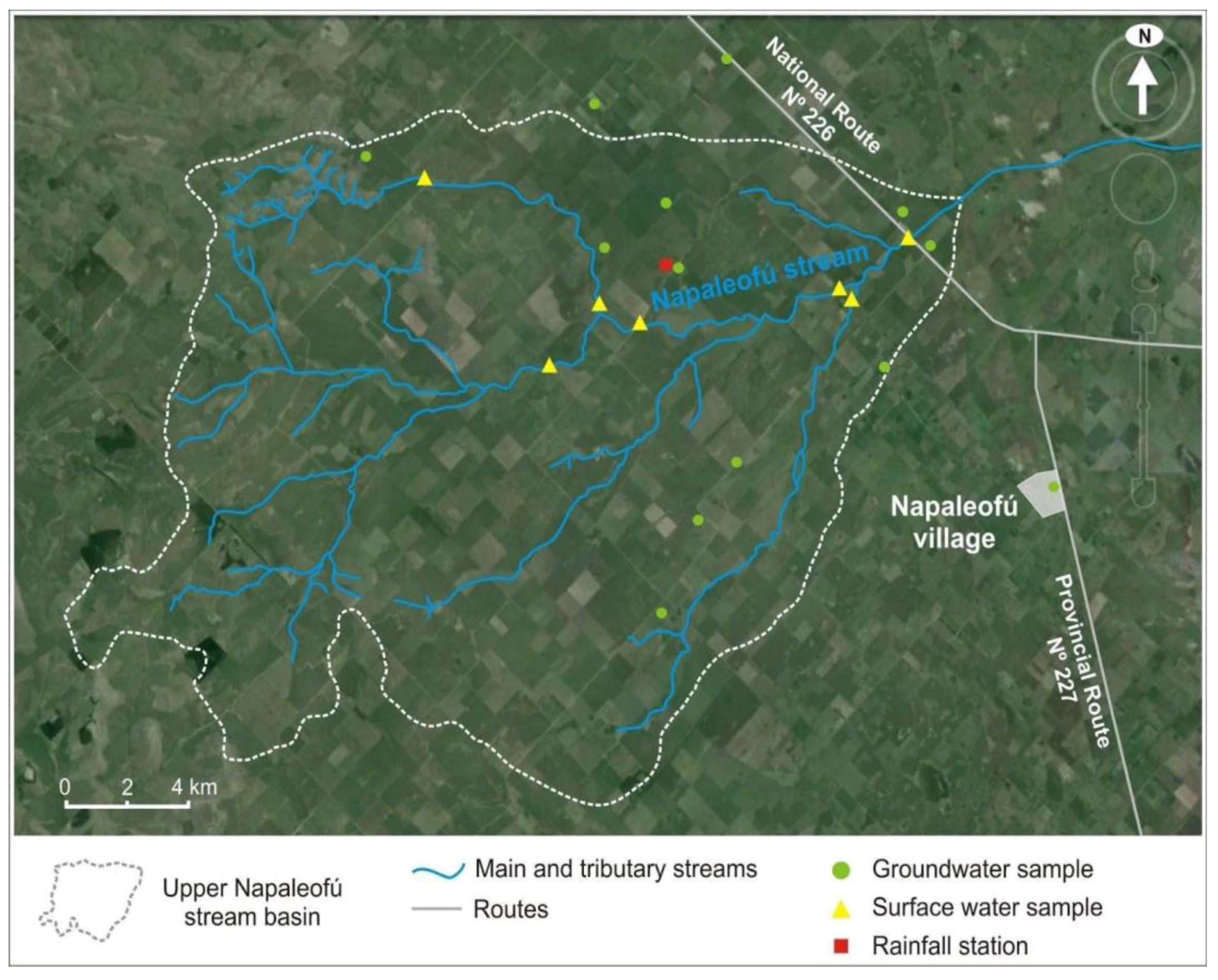
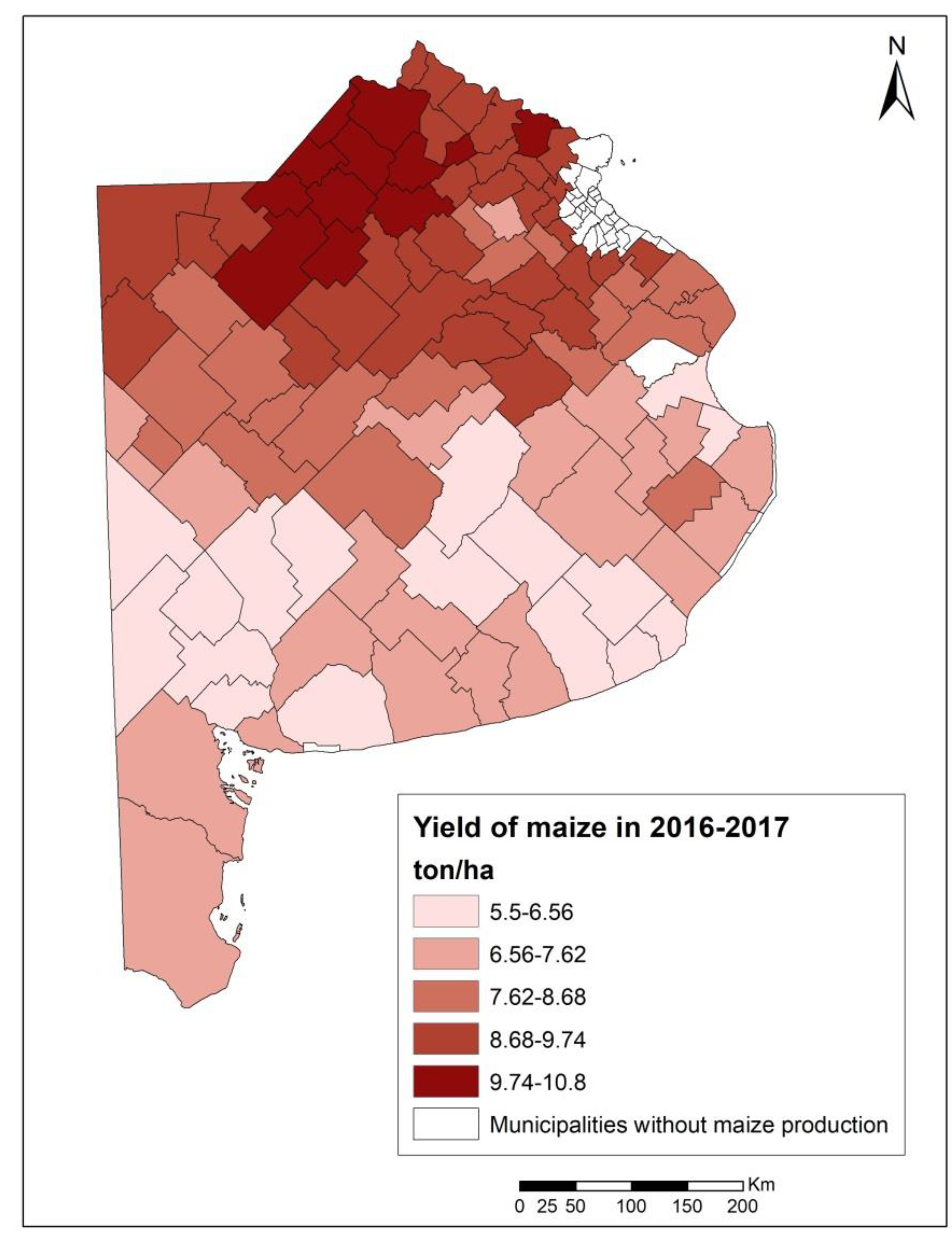
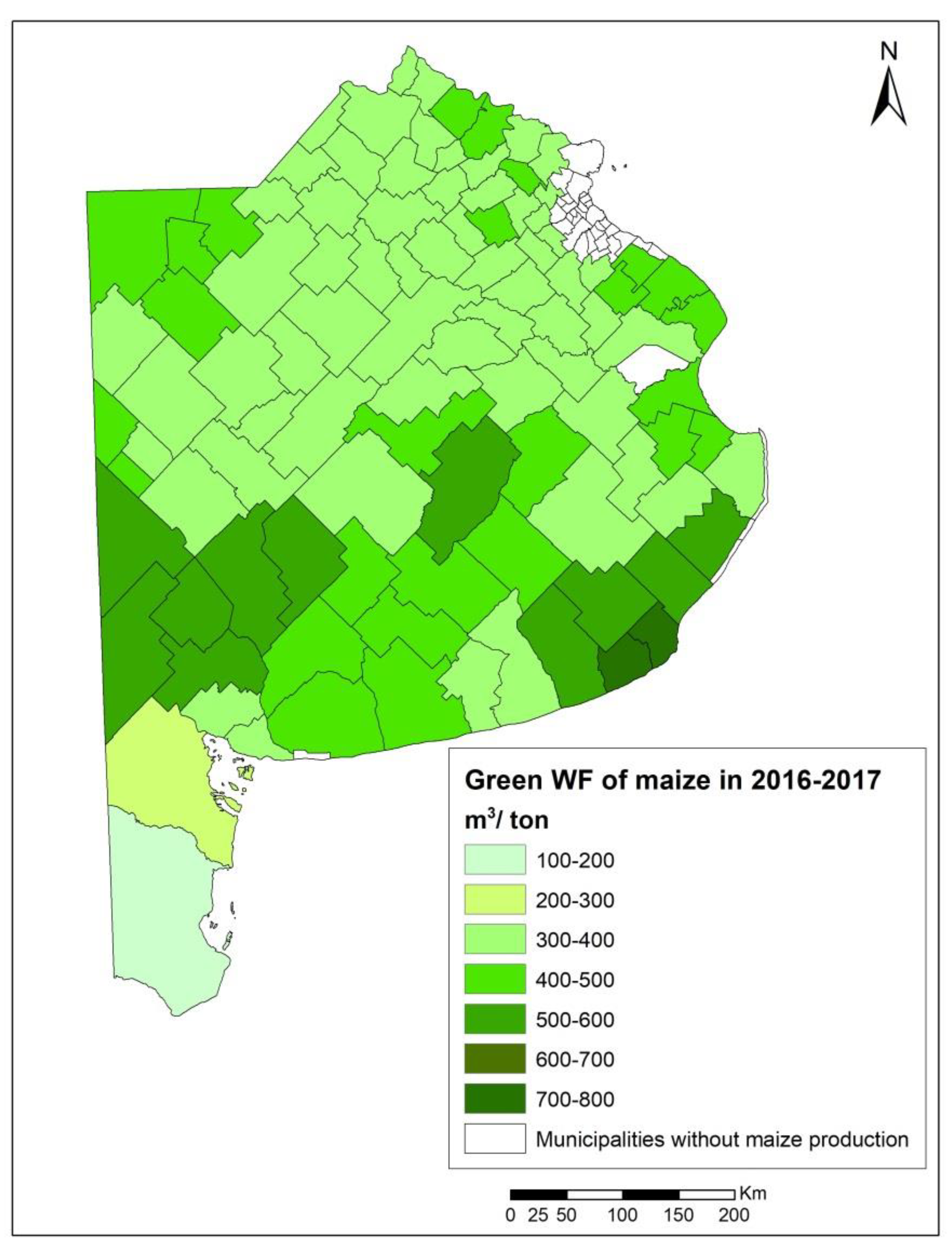
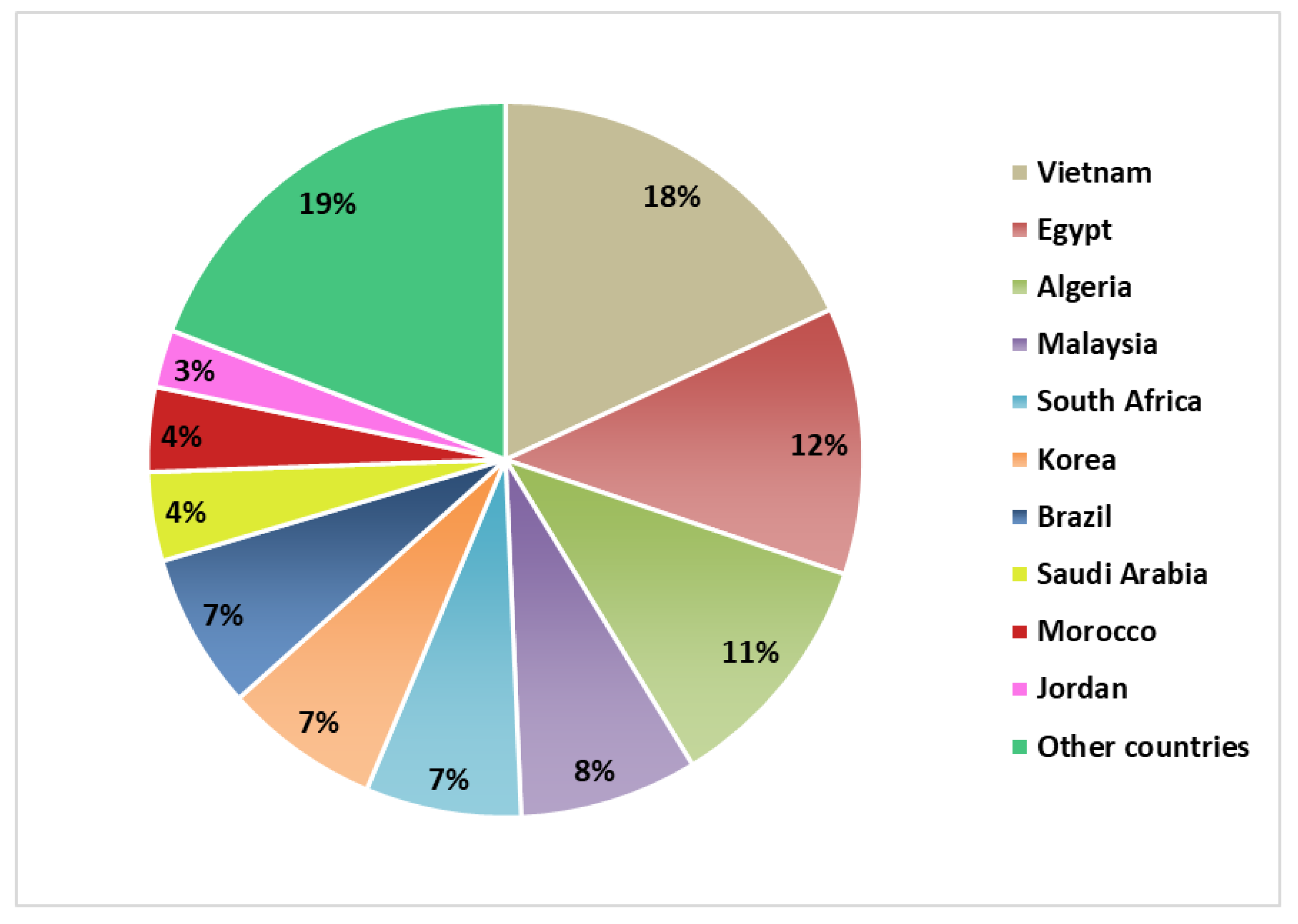

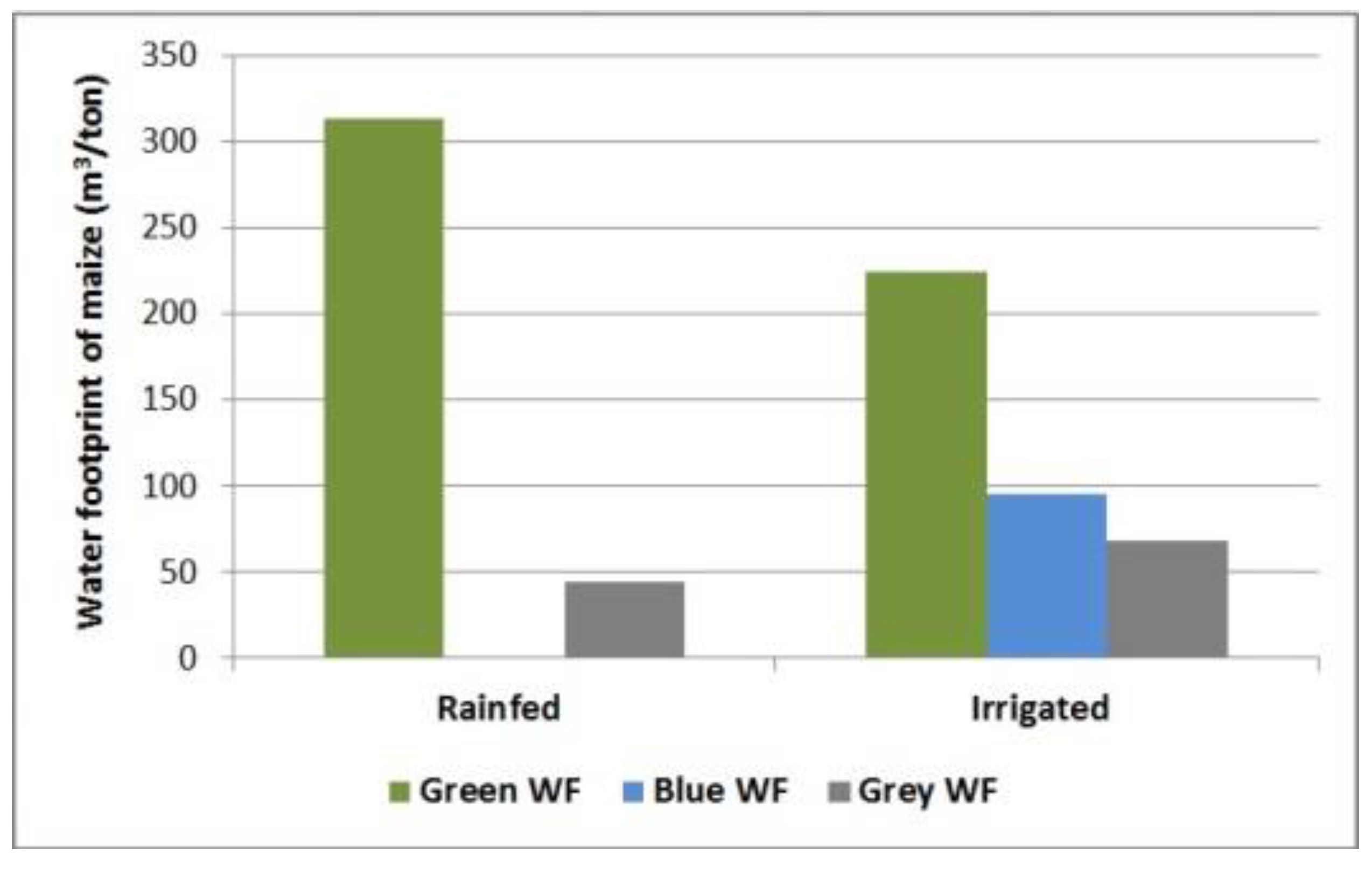
| Components | Values |
|---|---|
| Yield rainfed | 7.5 tons/ha |
| Yield under irrigation | 10.5 tons/ha |
| Effective irrigation water supply (Ieff) | 100.5 mm |
| Fertilizer application rate (Appl) (rainfed) | 150 kg/ha |
| Fertilizer application rate (Appl) (irrigated) | 325 kg/ ha |
| Maximum allowed concentration of nitrate in water (Cmax) | 0.045 kg NO3/m3 |
| Natural concentration of nitrate in water (Cnat) | 0 kg NO3/m3 (No data available) |
| Actual concentration of nitrate in water (Cact) | 0.034 kg NO3/m3 |
| Green Water Use (m3/ha) | Yield (tons/ha) | Green Water Footprint (m3/ton) | |
|---|---|---|---|
| Maximum | 4240 | 10.80 | 731.38 |
| Minimum | 1268 | 5.50 | 171.35 |
| Average | 3134 | 8.06 | 396.24 |
| Standard deviation | 474 | 1.45 | 83.23 |
| Country | Green Virtual Water (hm3) |
|---|---|
| Vietnam | 398.43 |
| Egypt | 265.62 |
| Algeria | 243.48 |
| Malaysia | 177.08 |
| South Africa | 154.94 |
| Korea | 154.94 |
| Brazil | 154.94 |
| Saudi Arabia | 88.54 |
| Morocco | 88.54 |
| Jordan | 66.40 |
| Other countries | 420.56 |
| Total | 2213.51 |
| Production System | WF Green | WF Blue | WF Grey (Cnat = 0) | Total WF | ||||
|---|---|---|---|---|---|---|---|---|
| Units | m3/ton | % | m3/ton | % | m3/ton | % | m3/ton | % |
| Rainfed | 313.73 | 87.6 | 0 | - | 44.44 | 12.4 | 358.17 | 100 |
| Irrigated | 224.1 | 57.7 | 95.71 | 24.6 | 68.78 | 17.7 | 388.59 | 100 |
| Rainfed/irrigated variations | −89.63 | −29.9 | 95.71 | 24.34 | +5.3 | 30.41 | +8.5 | |
Publisher’s Note: MDPI stays neutral with regard to jurisdictional claims in published maps and institutional affiliations. |
© 2021 by the authors. Licensee MDPI, Basel, Switzerland. This article is an open access article distributed under the terms and conditions of the Creative Commons Attribution (CC BY) license (https://creativecommons.org/licenses/by/4.0/).
Share and Cite
Arrien, M.M.; Aldaya, M.M.; Rodriguez, C.I. Water Footprint and Virtual Water Trade of Maize in the Province of Buenos Aires, Argentina. Water 2021, 13, 1769. https://doi.org/10.3390/w13131769
Arrien MM, Aldaya MM, Rodriguez CI. Water Footprint and Virtual Water Trade of Maize in the Province of Buenos Aires, Argentina. Water. 2021; 13(13):1769. https://doi.org/10.3390/w13131769
Chicago/Turabian StyleArrien, Maria Macarena, Maite M. Aldaya, and Corina Iris Rodriguez. 2021. "Water Footprint and Virtual Water Trade of Maize in the Province of Buenos Aires, Argentina" Water 13, no. 13: 1769. https://doi.org/10.3390/w13131769
APA StyleArrien, M. M., Aldaya, M. M., & Rodriguez, C. I. (2021). Water Footprint and Virtual Water Trade of Maize in the Province of Buenos Aires, Argentina. Water, 13(13), 1769. https://doi.org/10.3390/w13131769








